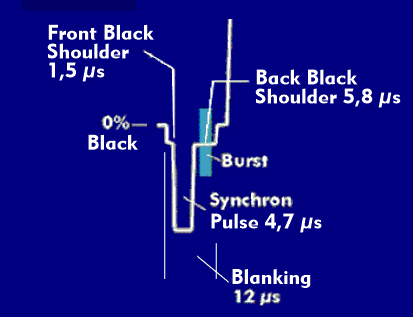synchronous puls
Synchronous pulses are part of the FBAS signal and other raster displays. They are used in television and video display to synchronize the individual lines and fields.
Each line starts with a horizontal synchronization pulse (H-Sync), which activates the horizontal deflection of the beam from left to right. If the electron beam is at the right edge of the screen, it is blanked during the blanking interval and guided back to the next line start during this time.
The same applies to the synchronization of the fields. Each field begins with a vertical synchronization pulse (V-Sync), which ensures that the vertical deflection of the electron beam occurs from top to bottom. Here, too, the beam return is blanked during the frame change.
According to television standards, the level of the sync pulse is below the black level so that it is not visible in the picture. In addition, it is darkened with the blanking interval. In front of the horizontal sync pulse is the front black shoulder, behind it is the rear black shoulder.

